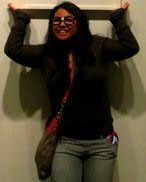I'm a student at Emerson College and this is my project for my Environment and Humankind (SC-205-02 1), which is taught by Jon Honea. The purpose of the project is to address a specific issue in one of four topics: human population growth, food production in America, global climate change, or energy.
I had some trouble thinking of an idea for the project, so I took Jon’s advice and did a project with activities I enjoyed outside of class(photography and blogging). I also wanted to do research on an environmental issue that doesn’t get a lot of coverage. Pollution has always piqued my interest and I stumbled upon light pollution.
In my project, I took pictures of examples of light pollution and waste in Boston. I also provide an explanation of light pollution and some different ways to reduce light pollution.
Wednesday, March 31, 2010
What is Light Pollution?
Light pollution or photopollution is the use of excessive or obtrusive artificial lighting. This type of pollution is especially relevant in cities such as Boston. Light pollution wastes energy, negatively affects both animal and human health and psychology, and disrupts ecosystems.
According to the U.S. Natural Park Service, which works under the U.S. Department of the Interior, light pollution is "Principally, the illumination of the night sky caused by artificial light sources, decreasing the visibility of stars and other natural sky phenomena. Also includes other incidental or obtrusive aspects of outdoor lighting such as glare, trespass into areas not needing lighting, use in areas where or at times when lighting is not needed, and disturbance of the natural nighttime landscape."
There are four types of light pollution. The first is sky glow, which is the brightening of the night sky in urban or inhabited areas. Sky glow is a major issue within cities. Light trespass, the second type, occurs when light falls in areas unintentionally or in areas where the light is unwanted or unneeded. The third type is bright light that reduces visibility and causes discomfort. Lastly, clutter is the grouping of excessively bright lights. Light clutter is another major issue in urban areas. (IDA Practical Guide)
According to the U.S. Natural Park Service, which works under the U.S. Department of the Interior, light pollution is "Principally, the illumination of the night sky caused by artificial light sources, decreasing the visibility of stars and other natural sky phenomena. Also includes other incidental or obtrusive aspects of outdoor lighting such as glare, trespass into areas not needing lighting, use in areas where or at times when lighting is not needed, and disturbance of the natural nighttime landscape."
There are four types of light pollution. The first is sky glow, which is the brightening of the night sky in urban or inhabited areas. Sky glow is a major issue within cities. Light trespass, the second type, occurs when light falls in areas unintentionally or in areas where the light is unwanted or unneeded. The third type is bright light that reduces visibility and causes discomfort. Lastly, clutter is the grouping of excessively bright lights. Light clutter is another major issue in urban areas. (IDA Practical Guide)
Light Pollution in North America
Harmful Effects of Light Pollution
Light pollution has been cited as the one of the causes of physical issues in humans. Extended exposure to light can cause a disruption of the body's metabolism. This disruption can cause an increased risk of obesity, type II diabetes, and heart disease. Oxidative stress, which is when the body cannot "readily detoxify" cells, is another result of light pollution that negatively affects the immune system and increases the risk of cancer. (Navara and Nelson 217). A study entitled "Night Shift Work, Light at Night and Risk of Breast Cancer" by Scott Davis, Dana K. Mirick, and Richard G. Stevens supported the theory that extended exposure to light is directly connected to an increased risk of breast cancer. In the study, Davis, Mirick,and Stevens observed that women who were unaware of light while sleeping were less likely to be diagnosed with cancer and that women who worked the graveyard shift and were exposed to light pollution were more likely to be diagnosed with cancer.
Wildlife is also negatively affected by light pollution. Light trespass is especially harmful to animals. This light pollution can disrupt the cycles of nocturnal animals and negatively affect cell function, brain activity, mating, and migratory behavior (IDA Practical Guide 2).
The chart shows the effects of light pollution to health. (Navara and Nelson 216)
Reducing Light Pollution
There are many very simple ways to reduce light pollution. One way is to direct light downwards instead of upwards, which is referred to as Shielded Lights or Full Cut-off. This will decrease the effect of the dispersed light (Natural Lightscapes Overview).
The IDA Practical Guide offers three additional ways to reduce light:
only use light when and where needed, use needed amount of light only, use efficient light sources outdoors. Lastly, the best way to reduce light pollution is to turn off unused or extraneous lights (Narisada and Schreuder 18). Many cities in Massachusetts and throughout New England have adopted lighting regulations; however, Boston is not one of them. Light pollution is deceptively dangerous environmental concern and it deserves more attention.
Examples of bad and good light fixtures (Natural Landscapes Overview)
only use light when and where needed, use needed amount of light only, use efficient light sources outdoors. Lastly, the best way to reduce light pollution is to turn off unused or extraneous lights (Narisada and Schreuder 18). Many cities in Massachusetts and throughout New England have adopted lighting regulations; however, Boston is not one of them. Light pollution is deceptively dangerous environmental concern and it deserves more attention.
Subscribe to:
Comments (Atom)





